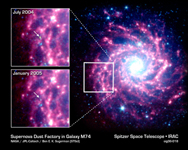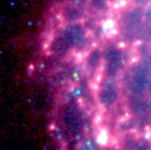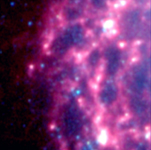
Figure 1: Supernova Dust Factory in Galaxy M74
 |  |
| Figure 2: July 2004 | Figure 3: January 2005 |
This image is the galaxy M74, as seen by Spitzer's infrared array camera. The white box (see figure 1) to the left of the galaxy's center identifies the location of the supernova remnant. In all the images, the blue dots represent hot gas and stars. The galaxy's cool dust is shown in red.
Astronomers using NASA's Spitzer Space Telescope have spotted a "dust factory" 30 million light-years away in the spiral galaxy M74. The factory is located at the scene of a massive star's explosive death, or supernova.
While astronomers have suspected for years that supernovae could be producers of cosmic dust particles, the technology to confirm this suspicion has only recently become available.
The dust factory, also known as supernova SN 2003gd, is shown at the center of the two small insets from Spitzer's infrared array camera. A white arrow points to its exact location (see figure 1). The yellow-green dot shown in the July 2004 inset (see figure 2) shows that the source's temperature is warmer than the surrounding material. This is because newly formed dust within the supernova is just starting to cool. By January 2005, the dust had cooled and completely faded from the camera's view (see figure 3). However, it was still detected in January 2005 by another instrument aboard Spitzer called the multiband imaging photometer. The image from that instrument is not shown here.
The images are false-color, infrared composites, in which 3.6-micron light is blue, 4.5-micron light is green, and 8-micron light is red.

